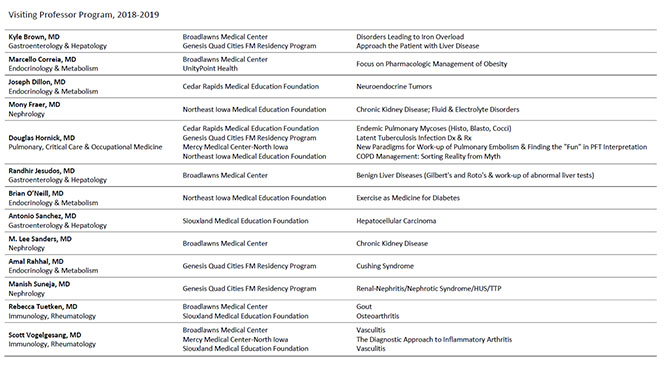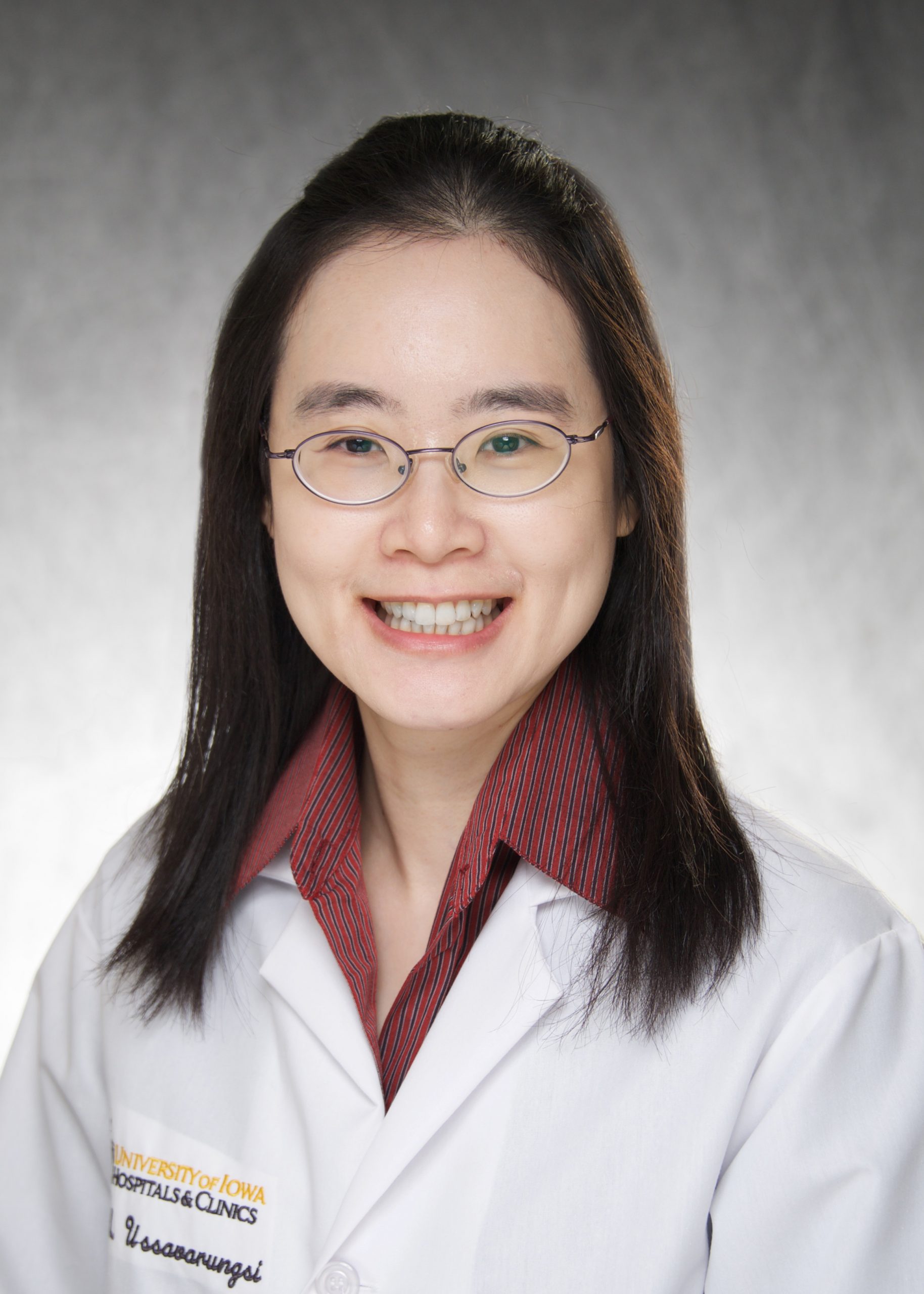There are few activities in this role that drive home for me the importance of each component of our mission than leading Chair’s Rounds each Thursday morning. I look forward very much to accompany our Chief Residents and trainees to round on patients that represent the breadth and diversity of the clinical cases on our Internal Medicine service. It is clear to me that our patients, many of whom traveled far to be here, are generally relieved to be at our institution. There is nowhere else in the state that has the expertise, intellectual resources, and diagnostic firepower to manage their conditions, which are often too complex or require a greater well of resources than can be managed in their communities. University of Iowa Health Care is the last, best hope for many, many Iowans, and we are honored by their trust to guide them back toward health and independence. We are also grateful for their willingness to share their experiences, sometimes, with rooms full of white coats.
 Because as much as it is a healing experience for our patients, it is also an educational experience for our trainees, from medical students to residents and fellows. As such, I want to underscore here, the critical importance of bedside teaching. Our patients’ stories are always instructive and we should avoid the tendency to get all of our information from the electronic medical record and minimize the bedside conversation. Moreover, all the patients that I see with the team reveal obvious but often subtle physical findings or other clinical clues that are critical for us not to overlook. A focus on rigorous bedside teaching will ensure that all of our trainees will leave Iowa with clinical skills that will define their careers and distinguish our trainees. I acknowledge that bedside teaching sometimes seems at odds with the demands on our increasingly busy faculty and the pressure to free-up beds. But there is no substitute for deliberative dialogue if our goal is to train the complete physician with a mastery of clinical reasoning and confidence in not only making the correct diagnoses, but also in developing meaningful therapeutic relationships with their patients. I would also argue that spending time with our patients in this way could actually increase the efficiency with which we comprehensively manage their sometimes complex problems, while increasing our patient’s satisfaction for the care that they receive. No matter the pressures, we must always remember that we are a teaching hospital.
Because as much as it is a healing experience for our patients, it is also an educational experience for our trainees, from medical students to residents and fellows. As such, I want to underscore here, the critical importance of bedside teaching. Our patients’ stories are always instructive and we should avoid the tendency to get all of our information from the electronic medical record and minimize the bedside conversation. Moreover, all the patients that I see with the team reveal obvious but often subtle physical findings or other clinical clues that are critical for us not to overlook. A focus on rigorous bedside teaching will ensure that all of our trainees will leave Iowa with clinical skills that will define their careers and distinguish our trainees. I acknowledge that bedside teaching sometimes seems at odds with the demands on our increasingly busy faculty and the pressure to free-up beds. But there is no substitute for deliberative dialogue if our goal is to train the complete physician with a mastery of clinical reasoning and confidence in not only making the correct diagnoses, but also in developing meaningful therapeutic relationships with their patients. I would also argue that spending time with our patients in this way could actually increase the efficiency with which we comprehensively manage their sometimes complex problems, while increasing our patient’s satisfaction for the care that they receive. No matter the pressures, we must always remember that we are a teaching hospital.
 Education does not just happen within the walls of our hospital or even across the street in the clinics and procedure suites at the VA Medical Center. Every fall and spring a cluster of events bring regional providers to our area to learn the latest updates in treatments and approaches for their subspecialty. These events have been running for many years–in some cases, decades–but organizers continue to find ways to innovate in how they present their material. Please review the upcoming opportunities for continuing medical education and make plans to attend. CME is just one way our faculty connects with those outside the institution. The Office of Statewide Clinical Education Programs recently shared with me its final data for the preceding academic year and once again, Internal Medicine has contributed heavily to the Visiting Professor Program. Thirteen faculty from five divisions filled more than a fifth of all total sessions provided. Thank you to the faculty listed below for the time and effort taken to travel to these locations to share your expertise.
Education does not just happen within the walls of our hospital or even across the street in the clinics and procedure suites at the VA Medical Center. Every fall and spring a cluster of events bring regional providers to our area to learn the latest updates in treatments and approaches for their subspecialty. These events have been running for many years–in some cases, decades–but organizers continue to find ways to innovate in how they present their material. Please review the upcoming opportunities for continuing medical education and make plans to attend. CME is just one way our faculty connects with those outside the institution. The Office of Statewide Clinical Education Programs recently shared with me its final data for the preceding academic year and once again, Internal Medicine has contributed heavily to the Visiting Professor Program. Thirteen faculty from five divisions filled more than a fifth of all total sessions provided. Thank you to the faculty listed below for the time and effort taken to travel to these locations to share your expertise.
click above image for larger view
Congratulations are also in order for some recent education-related successes. First, Dr. Greg Schmidt has now successfully led the organization of an annual symposium that not only showcases the best of the Carver College of Medicine, but also the best of our beautiful state. With significant support from our Pulmonary Division, the Midwest Critical Care Fellows Ultrasound Symposium demonstrates our commitment to finding efficiency and efficacy in the care of our patients by teaching first-year critical care fellows how to improve their bedside diagnostic skills. Congratulations are also due to third-year resident Thorarinn Bjarnason, MD, and now PhD, on the recent completion of his doctoral degree from the University of Iceland. In June, Dr. Bjarnason successfully defended his PhD dissertation, “Type 2 Diabetes Mellitus in the Acute Coronary Syndrome,” a topic I look forward to discussing further with him. To do so in the midst of one’s residency program is noteworthy, but to do so from across international borders and multiple time zones is an additional feat. Well done, Thor!
Finally, I am always pleased to share stories of our faculty serving the profession at regional and national levels. Volunteering in working groups and serving in leadership roles on committees lends prestige to our institution and our department by demonstrating the excellence we know well exists here. So, congratulations and thank you to Dr. Tahaunty Pena, recently appointed as regional representative on the Minority Affairs committee of the United Network for Organ Sharing. Dr. Pena has previously served on the Human Rights Commission for the City of Iowa City. Dr. Lee-Ann Allen deserves congratulations for her appointment to a four-year term on the Federation of American Societies for Experimental Biology Board of Directors. Dr. Allen is no stranger to national organizations, as she is just now completing the second year of her term as president of the Society for Leukocyte Biology.


